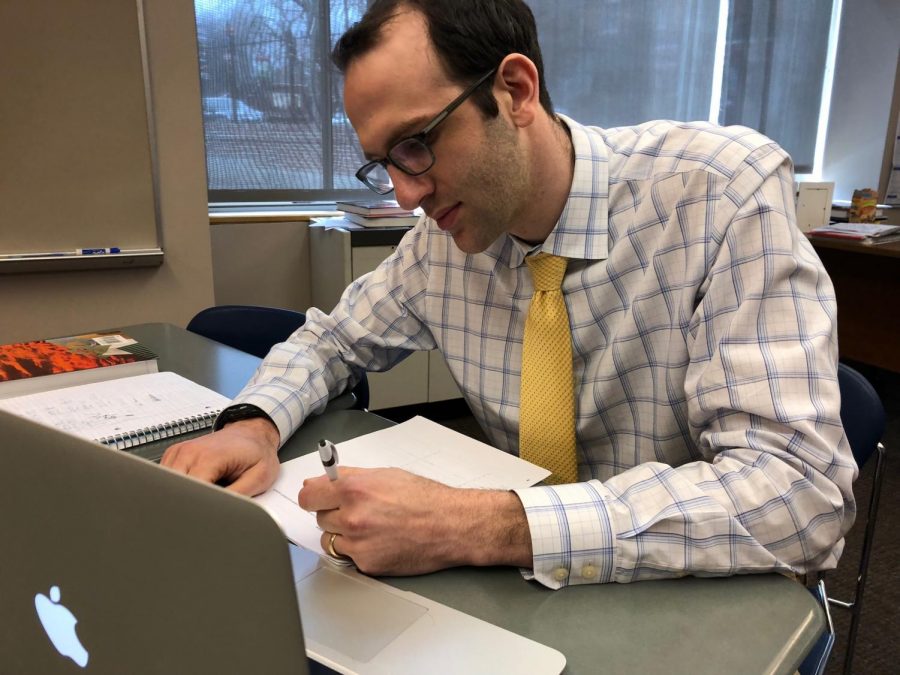Grading Our Futures
What Methods of Receiving Grades Do Students Prefer
Photo credit: Zach Joseph
Upper School Math teacher Ethan Levine grades a student’s math test in his free time.
Right or wrong, almost all high school students care about grades. They’ve been a staple of school since 1792, when a tutor at Cambridge University named William Farish invented the modern grading system. But when should students get to see them, and how?
For years, Parker students have been able to view their grades officially in just one way: mid-semester and semester reports. But with the shift to the Portal, students can now view grades online as the year progresses–if their teacher elects that feature.
Freshman Leila Sheridan likes the availability of grades on the Portal. “It’s easy,” Sheridan said, “and you can also see the breakdown of the percents of quizzes, tests, class participation, homework.”
At the beginning of the school year, the Senate heads created a proposal that would allow students to approach teachers at any time, to ask for grades. The ideas was that teachers would be expected to tell students their current grades. The proposal was created when Senate heads found that their personal experiences with grade access were widely felt across the Upper School.
“It seemed like this was a pretty common experience across the high school,” junior and Senate head Jenna Mansueto said, “and a lot of students didn’t feel like they knew what their grades were, and felt uncertain in their classes.”
The proposal was introduced to the faculty on November 2, but has yet to be implemented.
Some teachers feel that they already follow the guidelines of the new proposal. Bonnie Seebold, an Upper School English teacher, feels that teachers are obligated to keep students informed on their progress in class. Seebold said, “I think it is my responsibility to answer the question if a student asks me, ‘What grade am I getting at this point in time?’” Seebold recommends that students ask if they ever have any questions, but she wonders if some students are too afraid to ask.
Seebold doesn’t believe, however, that grades are a positive way to assess students. Seebold said, “I think grades are antithetical to learning.” She gives grades along the way for the sole reason that she has to on semester reports, but she does not like the practice.
Sheridan agrees. “I don’t think that grades fairly represent the work and dedication that you can put into a class,” Sheridan said. “In history, my class was writing an in-class essay about North Korea, and it was a three-week-long unit, and I worked so hard, every single night, and I did not do well on the essay, and that one essay determined my knowledge for the whole unit.”
Mansueto understands why some teachers might be concerned about students’ being able to receive their grades at any time. “I know a lot of teachers were concerned with this proposal, that it would make students focus more on grades, and maybe devalue the actual education,” Mansueto said, “but as Parker students who have experienced these problems, we feel like grades, while they do play an important role in our education, aren’t the sole reason why students are attending class every day.”
Currently students are able to ask teachers for grades at any time, and teachers can decide whether or not to share the information. According to an anonymous survey of Upper School students completed by 105 students, about 48.5% of individuals said that they view grades only on semester reports, 31.3% said they view grades on the Portal, 13.1% said they receive grade information directly from teachers, and the remaining 7.1% of students responded in other ways, saying there was no way to find out, or they simply didn’t know.
When asked what the best and easiest way to view grades would be, 60.6% said the Portal, 15.2% said talking directly to teachers, and the remaining 24.2% said other options, like having teachers keep regularly updated gradebooks and mandatory monthly grade reports.
According to 60% of the surveyed students, the Portal should be the main source of grades in the Upper School.
Sheridan agreed, saying, “I think if you talk to a teacher then you can’t exactly–unless they give you a full breakdown–understand where the number is coming from.”
Sheridan shared an anecdote. “I went up to one of my teachers, and I asked them about my grade because it was right before the final, and I just wanted to know what I was going into the final with,” Sheridan said. “They gave me a range of a B+ to an A. That was just not clear, whatsoever, so I had no idea how I was doing in the class.”








